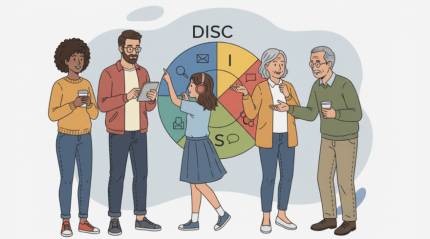Your Definitive Guide to Style Assessments for Self-Discovery and Team Success
- 24 October 2025

Take DISC Personality Assessment Online
Get StartedWhat This Guide Covers and Why It Matters
Unlocking how you naturally communicate, make decisions, and respond to stress can transform your career and relationships. Well-designed style assessments illuminate the behavioral patterns you lean on most, turning vague self-perception into practical insights. Instead of relying on hunches, you gain evidence-based language for strengths, blind spots, and growth paths. That language becomes a compass for tough conversations, performance reviews, and collaboration.
Across industries, leaders use structured profiling tools to clarify expectations and avoid costly misalignment. Among the most accessible tools for newcomers, the personality style quiz translates abstract patterns into plain language that fuels meaningful action. You’ll see why your colleague thrives on rapid change while another prefers meticulous planning, and you’ll adjust your approach accordingly. The outcome isn’t pigeonholing; it’s precision, right person, right role, right rhythm.
This article explains the underlying psychology, shows tangible workplace and life benefits, and provides a step-by-step roadmap for getting reliable results. You’ll also find a concise matrix to compare core style signals at a glance, plus an FAQ that addresses selection, accuracy, and cost. Whether you’re a hiring manager, a coach, or simply someone curious about better self-management, you’ll come away ready to use your results confidently and ethically.
The Psychology and Methodology Behind Modern Assessments
Effective behavioral inventories rest on clear constructs and consistent measurement. Most reputable tools draw on trait theory, behavioral observation, and large-scale validation studies. They use item banks that differentiate between everyday preferences and situational adaptations, pairing statistical techniques, like item-response theory and factor analysis, with rigorous norming. That depth ensures the instrument distinguishes similar traits without blurring important boundaries.
Reliability is foundational. Look for internal consistency coefficients that indicate items are measuring the same latent concept, and test–retest data proving stability across reasonable time windows. Validity matters just as much: convergent validity ensures alignment with related constructs, while discriminant validity guards against conceptual overlap. Criterion validity shows whether the assessment predicts meaningful outcomes such as sales productivity, leadership effectiveness, or customer satisfaction.
Ethical deployment also matters. Transparent consent, clear feedback, cultural fairness, and appropriate interpretation protect participants from misuse. Coaches and HR leaders should frame results as tendencies, not destiny. High-quality instruments include bias reviews, multilingual calibrations, and ongoing research updates. When you see these safeguards in place, you can trust that the profile you receive offers accurate, actionable guidance rather than simplistic labels that limit potential.
Real-World Benefits for Workflows, Leadership, and Relationships
When individuals understand their default patterns, they make smarter trade-offs. A decisive person learns when to pause for input, while a consensus-builder trains themselves to take a timely stand. Teams that adopt a shared behavioral vocabulary can de-escalate conflict and negotiate roles more smoothly. Managers translate “do better” into specific, coachable behaviors and set expectations that map to how people naturally execute.
For teams that favor a structured behavioral typology, the DISC personality quiz offers a shared vocabulary for drive, influence, steadiness, and conscientiousness that managers can use during 1:1s. The payoff shows up in onboarding speed, meeting efficiency, and fewer crossed wires. Instead of guessing how to present data to stakeholders, you tailor the format and pacing to the receiver’s style, earning faster approvals.
- Sharpened communication: choose words, tone, and channel that resonate with diverse recipients.
- Conflict prevention: spot triggers early and repivot conversations constructively.
- Role alignment: assign projects matching attention to detail, urgency, or collaboration needs.
- Change readiness: identify who needs context versus who thrives on swift iteration.
- Customer insight: map service scripts to the behavioral patterns of buyer personas.
Outside of work, partners and friends benefit too. You may learn why texting feels cold to one person but efficient to another. That understanding curbs resentment, strengthens trust, and encourages mutually satisfying boundaries. Over time, you’ll see better energy management, clearer requests, and a more compassionate reading of others’ intent.
Quick Reference Matrix of Styles, Signals, and Best-Fit Situations
Use the following matrix as a fast way to decode common behavioral signals and align tasks accordingly. It is not a diagnosis; rather, it’s a lens for planning communication, feedback, and workflow. Consider it a launch point for deeper inquiry, coaching, and deliberate practice. Pair these cues with lived observations and performance data for a complete picture.
| Core Style Signal | Observable Behaviors | Strengths | Stress Triggers | Best-Fit Tasks | Common Pitfalls |
|---|---|---|---|---|---|
| Decisive Driver | Speaks directly, acts quickly, pushes for outcomes | Momentum, clarity, risk tolerance | Bureaucracy, slow consensus cycles | Crisis response, goal setting, negotiations | Impatience, limited listening, and over-simplification |
| Engaging Influencer | Story-driven, energetic, people-connecting | Inspiration, persuasion, visibility | Isolation, data-heavy updates without context | Evangelism, onboarding, community building | Over-commitment, detail slippage, optimism bias |
| Steady Supporter | Calm tone, patient pacing, consensus-seeking | Team harmony, reliability, loyalty | Last-minute changes, unclear priorities | Customer care, operations cadence, training | Change resistance, avoidance of hard feedback |
| Conscientious Analyst | Structured questions, thorough documentation | Accuracy, risk control, quality | Ambiguity, rushed decisions without evidence | Compliance, QA, data modeling | Analysis paralysis, perfectionism, and narrow framing |
Interpret signals contextually. Someone who appears “decisive” in emergencies might prefer collaborative planning during stable periods. Likewise, a “conscientious” teammate can ship faster when given acceptable error bounds and a clear definition of done. Match your communication to these realities: offer crisp summaries to drivers, stories to influencers, reassurance to supporters, and evidence to analysts.
How to Take and Interpret Your Results Like a Pro
Preparation improves accuracy. Choose a quiet setting, silence notifications, and approach the instrument with curiosity rather than performance anxiety. Answer items based on typical behavior, not idealized behavior. If the tool offers “work” versus “home” frames, pick the one most relevant to your current goals. Timing matters too, avoid testing right after a stressful event that could skew your responses.
- Before starting: clarify your aim, better leadership, hiring fit, or communication upgrades.
- During the assessment: respond quickly and honestly to reduce overthinking artifacts.
- Immediately after: skim your summary for top themes and immediate application points.
- Within 48 hours: translate insights into two habits to start and one habit to stop.
- At 30 days: review impact metrics like cycle time, meeting outcomes, or feedback quality.
Interpretation is where value compounds. Compare your natural preferences with role demands, then set micro-experiments. For instance, if you are highly methodical, block time for rapid prototyping to widen your range. If you tend toward high urgency, schedule deliberate pauses for stakeholder check-ins. Share your profile with teammates and invite theirs; mutual transparency accelerates trust. Finally, revisit results after major role changes to ensure your development plan stays aligned with new constraints.
FAQ: Your Top Questions Answered
How accurate are these assessments?
Accuracy depends on instrument quality and honest responses. Reputable tools publish reliability and validity evidence and update norms periodically to reflect diverse populations. Read the technical manual when available and favor assessments with clear constructs and transparent research. Self-awareness also grows with reflection, so pair results with feedback and real-world experiments for stronger signal.
Which assessment should I choose for my team?
Start by clarifying your use case: hiring, coaching, conflict navigation, or change management. Then evaluate instruments for clarity, practicality, and training resources for managers. If budget or time is tight, many providers offer a free DISC personality quiz with brief items and instant summaries that can support an initial conversation. As your needs mature, consider upgraded versions that include deeper reports and facilitator guides.
How often should I retake an assessment?
Most people show stable tendencies, so frequent retesting is unnecessary. Retake when your role changes significantly, after high-impact life events, or when a development plan feels stale. Use a consistent context for comparisons, and focus on trend lines rather than minor score shifts.
Can these tools reduce bias in hiring?
They can help, but only when used ethically and alongside structured interviews, work samples, and clear competencies. Treat results as one data point among many and avoid disqualifying candidates solely based on style. Provide accommodations, ensure fairness checks, and train interviewers on interpretation limits.
What should I do if my results surprised me?
Surprise can signal growth edges or situational adaptations. Journal examples that confirm or challenge the profile, then ask trusted colleagues for behavioral observations. Set small experiments to test new approaches and refine your working model of yourself over time.
Bringing It All Together: From Insight to Everyday Impact
Assessment results become powerful only when converted into repeatable habits. Translate each takeaway into a micro-behavior: a template for status updates, a meeting agenda tweak, or a checklist for risk reviews. Share your preferences with peers, document collaboration agreements, and codify what “good” looks like for different project stages. That operationalization is what turns a nice-looking report into measurable performance gains.
If you’re leading a team, socialize a common vocabulary and practice it in retrospectives and debriefs. Build rituals that honor different pacing needs: quick huddles for urgency, deep dives for rigor, and space for relational check-ins. Track outcomes, cycle time, error rates, employee NPS, and attribute improvements to specific behavior changes rather than vague intentions. Over months, you’ll notice fewer misfires, richer debates, and momentum that compounds.
Self-knowledge is a leadership multiplier. Invest a small window of focused attention now, and you’ll save hours of friction later. Use a reliable tool, apply the insights deliberately, and keep iterating as your context evolves. Momentum follows clarity, and clarity starts with understanding how you naturally show up under pressure and in flow.



